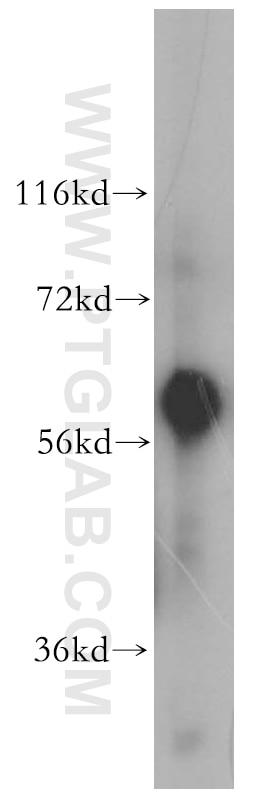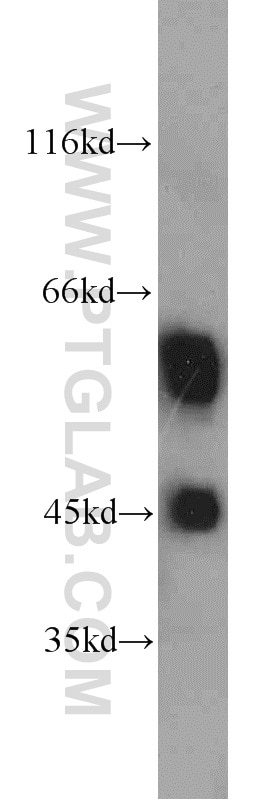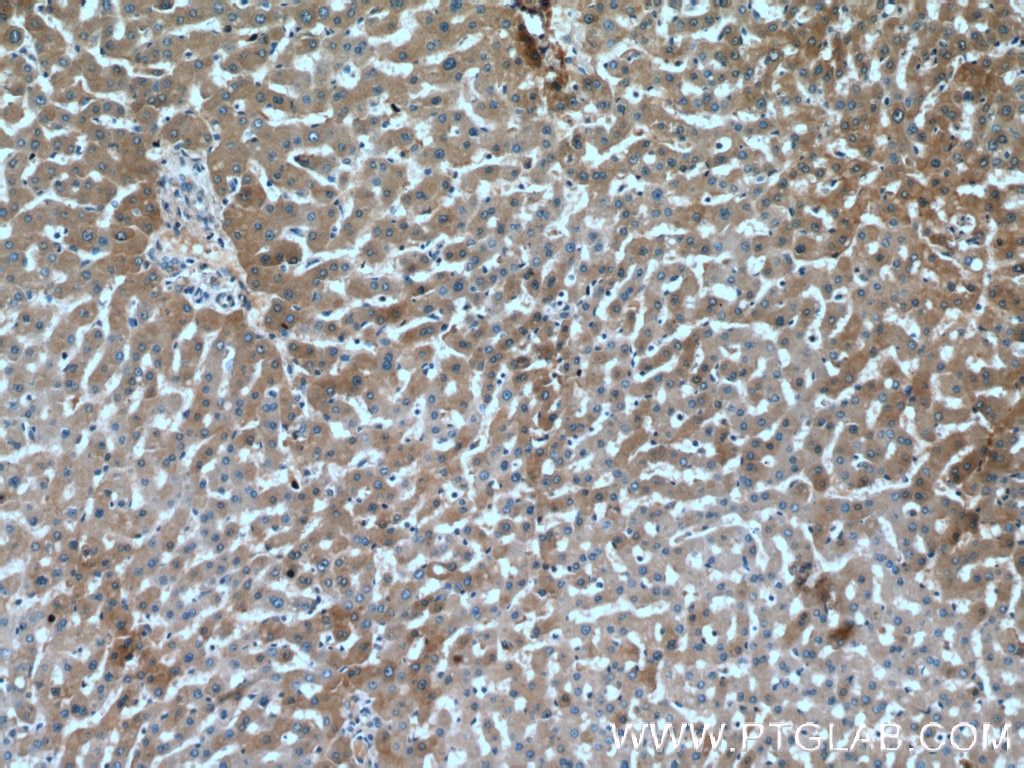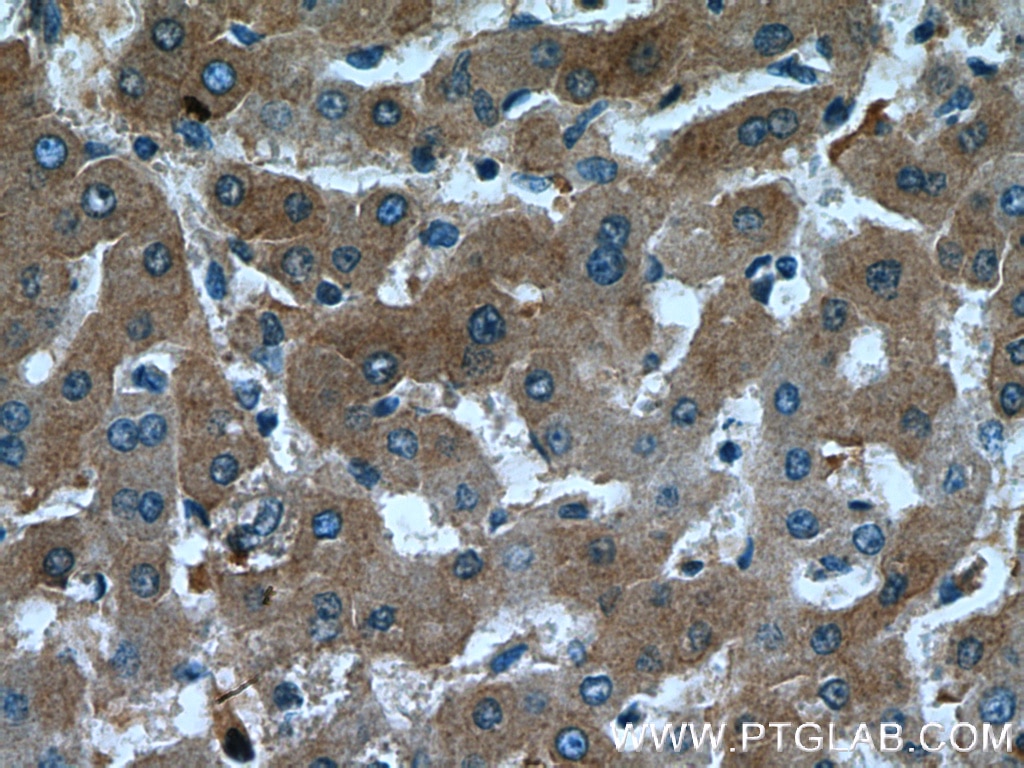Fetuin-A/AHSG Polyklonaler Antikörper
Fetuin-A/AHSG Polyklonal Antikörper für WB, IHC, ELISA
Wirt / Isotyp
Kaninchen / IgG
Getestete Reaktivität
human und mehr (3)
Anwendung
WB, IHC, IF, ELISA
Konjugation
Unkonjugiert
Kat-Nr. : 16571-1-AP
Synonyme
Geprüfte Anwendungen
| Erfolgreiche Detektion in WB | humanes Lebergewebe, humanes Herzgewebe |
| Erfolgreiche Detektion in IHC | humanes Lebergewebe Hinweis: Antigendemaskierung mit TE-Puffer pH 9,0 empfohlen. (*) Wahlweise kann die Antigendemaskierung auch mit Citratpuffer pH 6,0 erfolgen. |
Empfohlene Verdünnung
| Anwendung | Verdünnung |
|---|---|
| Western Blot (WB) | WB : 1:500-1:1000 |
| Immunhistochemie (IHC) | IHC : 1:50-1:500 |
| It is recommended that this reagent should be titrated in each testing system to obtain optimal results. | |
| Sample-dependent, check data in validation data gallery | |
Veröffentlichte Anwendungen
| WB | See 6 publications below |
| IHC | See 2 publications below |
| IF | See 1 publications below |
Produktinformation
16571-1-AP bindet in WB, IHC, IF, ELISA Fetuin-A/AHSG und zeigt Reaktivität mit human
| Getestete Reaktivität | human |
| In Publikationen genannte Reaktivität | human, Maus, Ratte, Plasmodium falciparum |
| Wirt / Isotyp | Kaninchen / IgG |
| Klonalität | Polyklonal |
| Typ | Antikörper |
| Immunogen | Fetuin-A/AHSG fusion protein Ag9853 |
| Vollständiger Name | alpha-2-HS-glycoprotein |
| Berechnetes Molekulargewicht | 367 aa, 39 kDa |
| Beobachtetes Molekulargewicht | 58 kDa |
| GenBank-Zugangsnummer | BC048198 |
| Gene symbol | Fetuin-A |
| Gene ID (NCBI) | 197 |
| Konjugation | Unkonjugiert |
| Form | Liquid |
| Reinigungsmethode | Antigen-Affinitätsreinigung |
| Lagerungspuffer | PBS with 0.02% sodium azide and 50% glycerol |
| Lagerungsbedingungen | Bei -20°C lagern. Nach dem Versand ein Jahr lang stabil Aliquotieren ist bei -20oC Lagerung nicht notwendig. 20ul Größen enthalten 0,1% BSA. |
Hintergrundinformationen
Fetuin-A, also named as Alpha2-HS glycoprotein (AHSG), is a member of cystatin superfamily of protease inhibitors. It is a highly expressed glycoprotein in various fetal tissues whereas it is mainly expressed by the liver in adults. Fetuin A, an extracellular inhibitor of transforming growth factor β, is a profibrogenic stimulus in liver disease. Circulating fetuin-A may be a beneficial serum biomarker in the detection of liver and vascular fibrosis progression in patients with non-alcoholic fatty liver disease. It is also involved in several functions, such as endocytosis, brain development and the formation of bone tissue. Fetuin-A exerts its effects on the cardiovascular system by two different mechanisms. On the one hand it inhibits ins signaling and induces ins resistance contributing to the onset of atherosclerosis and on the other hand it inhibits calcium deposition and protects from vascular calcification.
Protokolle
| PRODUKTSPEZIFISCHE PROTOKOLLE | |
|---|---|
| WB protocol for Fetuin-A/AHSG antibody 16571-1-AP | Protokoll herunterladen |
| IHC protocol for Fetuin-A/AHSG antibody 16571-1-AP | Protokoll herunterladenl |
| STANDARD-PROTOKOLLE | |
|---|---|
| Klicken Sie hier, um unsere Standardprotokolle anzuzeigen |
Publikationen
| Species | Application | Title |
|---|---|---|
Front Cell Dev Biol Plasma Exosomes Derived From Patients With End-Stage Renal Disease and Renal Transplant Recipients Have Different Effects on Vascular Calcification. | ||
Osteoarthritis Cartilage Proteomics analysis of hip articular cartilage identifies differentially expressed proteins associated with osteonecrosis of the femoral head. | ||
J Pharm Biomed Anal Integrated cartilage metabolomics and proteomics analysis reveals the therapeutic effect of Wenjing Tongluo Decoction on Knee osteoarthritis rats | ||
Malar J The malaria parasite Plasmodium falciparum in red blood cells selectively takes up serum proteins that affect host pathogenicity. | ||
Bioengineered Alpha-2 Heremans Schmid Glycoprotein (AHSG) promotes the proliferation of bladder cancer cells by regulating the TGF-β signalling pathway. | ||
Adv Sci (Weinh) 3D-hUMSCs Exosomes Ameliorate Vitiligo by Simultaneously Potentiating Treg Cells-Mediated Immunosuppression and Suppressing Oxidative Stress-Induced Melanocyte Damage |





